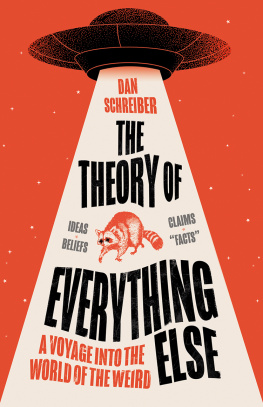Mudlark
An imprint of HarperCollinsPublishers
1 London Bridge Street
London SE1 9GF
www.harpercollins.co.uk
HarperCollinsPublishers
Macken House, 39/40 Mayor Street Upper
Dublin 1, D01 C9W8, Ireland
First published by Mudlark 2022
FIRST EDITION
Text Dan Schreiber 2022
Illustrations Sam Minton 2022
Cover layout design by Ellie Game HarperCollinsPublishers 2022
Jacket illustrations: animatedfunk/Getty Images (raccoon) and Shutterstock.com (spaceship)
While every effort has been made to trace the owners of copyright material reproduced herein and secure permissions, the publishers would like to apologise for any omissions and will be pleased to incorporate missing acknowledgements in any future edition of this book.
A catalogue record of this book is available from the British Library
Dan Schreiber asserts the moral right to be identified as the author of this work
All rights reserved under International and Pan-American Copyright Conventions. By payment of the required fees, you have been granted the nonexclusive, non-transferable right to access and read the text of this e-book on screen. No part of this text may be reproduced, transmitted, downloaded, decompiled, reverse engineered, or stored in or introduced into any information storage retrieval system, in any form or by any means, whether electronic or mechanical, now known or hereinafter invented, without the express written permission of HarperCollins e-books.
Find out about HarperCollins and the environment at
www.harpercollins.co.uk/green
Source ISBN: 9780008518974
Ebook Edition October 2022 ISBN: 9780008518998
Version: 2022-10-11
This ebook contains the following accessibility features which, if supported by your device, can be accessed via your ereader/accessibility settings:
- Change of font size and line height
- Change of background and font colours
- Change of font
- Change justification
- Text to speech
- Page numbers taken from the following print edition: ISBN 9780008518974
For Fenella, Wilf, Ted and Littlestfoot
My four favourite weirdos
What if a chicken is an eggs way
of making more eggs?
Anonymous
Foreword
There is a concept practised by Zen gardeners called the Rough Corner. The idea being that somewhere, in every beautifully tended garden, there should remain a patch of land left completely untouched, growing wild and chaotic so as to remind the gardener of how the universe intended it to look.
I believe we should all be cultivating a healthy Rough Corner in our minds. A small nook at the back of the brain that ensures we never fail to get goosebumps when were told a mad-as-hell idea, no matter how batshit it may be. Its important to keep this Rough Corner ragged and free to grow as nature intended, because great things have been achieved by those who believe in weird ideas
Disclaimer
The author of this work does not accept responsibility for any overgrown Rough Corners the reader might end up cultivating as a result of reading this book.
All the theories in this book want you to believe in them. Dont even think of it. Read up on them, yes; discuss them with your friends, definitely; sit back and let the ideas alter your universe for just a few seconds, absolutely; but for Gods sake, dont believe in a single one of them.
However, I know its not up to me what youll make of all these theories, no matter how much I warn you against them. Any idea you connect with that helps make sense of your place in this universe can develop into an unstoppable force.
To some extent all of these theories are alive; at least thats certainly the impression they give. Theyve been translated into multiple languages and are at this very moment being discussed at breakfast tables and dinner parties around the world. They crop up in innumerable school classrooms, are debated by the finest minds in the worlds leading universities and have become the all-consuming obsession of amateur sleuths. They have their own websites, social media accounts and Netflix specials. One has even done so well that it has its very own soundtrack, written and performed by Stevie Wonder.
Theyre all incredibly successful at being talked about and will do their absolute best to make you think that theyre true. But please remember, this isnt a book of facts; its a book of facts. None of the theories in this book are true. Theyre just ideas, speculations, beliefs and claims, begging to be accepted as truths. So, should you walk away at the end of this book believing that the only reason we became the dominant species on this planet is because predators found us too smelly to eat; or that the living descendants of Christ are a family of garlic farmers living in Japan; or that office plants should be employed as police detectives well, thats on you.
Not yet, anyway.
Introduction
In 1956 archaeologist George Michanowsky was plodding his way through a remote region of the Bolivian bush when he stumbled upon a group of locals partaking in a festival of dance, drink and general debauchery. After making some enquiries, Michanowsky learnt that this was an annual event, and that every year, for thousands of years now, whole communities from hundreds of miles away would gather together to celebrate.
Celebrate what? asked the archaeologist.
Cant remember, replied the Bolivians. Somewhere along the line, theyd all forgotten why they were actually doing this.
However, not ones to let a minor administrative error like that get in their way, they continued to meet up once a year to make sure to commemorate whatever it was they were supposed to be commemorating.
* * *
I first spotted this anthropological puzzle a few years back while flipping through a 1973 edition of Time magazine as I browsed a secondhand bookshop in London. Its a story Ive thought a lot about since. Though it may sound trivial, for me the mystery of the dancing Bolivians perfectly illustrates something thats at the very heart of this book: which is that no matter where you look in this world, you can guarantee that something bizarre, improbable and unexplained is going on. And, more importantly, no matter how small that mystery may seem, theres most likely someone (or something) out there dedicating their time to solving it.
Right now, as you read these words, there are scientists in Silicon Valley who are spending their days trying to work out if the universe is actually just a giant video game; there are ornithologists in Australia who are attempting to prove their theory that theres a species of bird singing pop songs from the 1920s in the wild; and in Poland there is a ghost hunter who continues to warn us of his belief that ghosts have become so annoyed by the recent rise of scepticism about their existence, that theyre threatening to go on strike. If youre going to have that attitude, were not going to bother haunting you anymore appears to be the message.
Everyone, it seems, has a theory theyre trying to prove be it about something as big as the meaning of life, or as small as trying to work out why Australians speak the way they do.
We dont know the answers to any of these questions, but in this book Ill be introducing you to some people who think theyve more or less figured them out. Along the way youll learn the word for thank you in plant language from a leading botanist; youll be invited by conservationists to help save an endangered species from being shampooed out of existence; and youll discover why you should probably try to avoid winning a Nobel Prize in the Sciences. Most importantly, though, youll learn that pretty much everyone in the world harbours their own little bit of batshit.











